Page 100 of 404
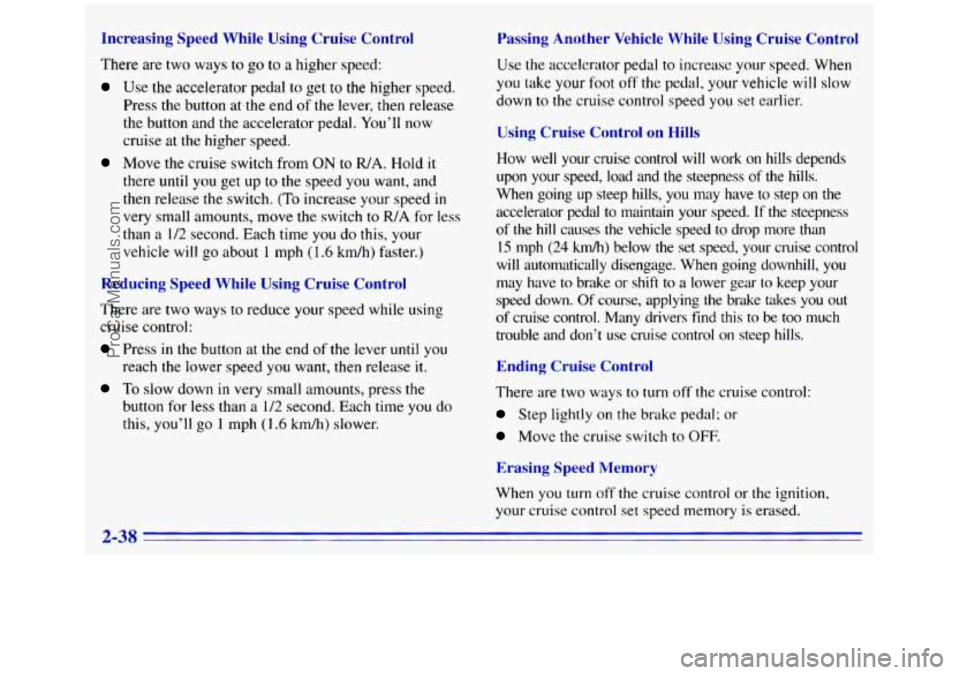
Increasing Speed While Using Cruise Control
There are two ways to go to a higher speed:
Use the accelerator pedal to get to the higher speed.
Press the button at the end
of the lever, then release
the button and the accelerator pedal.
You’ll now
cruise at
the higher speed.
Move the cruise switch from ON to WA. Hold it
there until you get up
to the speed you want, and
then release the switch.
(To increase your speed in
very small amounts, move the switch to R/A for less
than a
1/2 second. Each time you do this, your
vehicle will go about
1 mph (1.6 kmh) faster.)
Reducing Speed While Using Cruise Control
There are two ways to reduce your speed while using
cruise control:
Press in the button at the end of the lever until you
reach the lower speed you want,
then release it.
To slow down in very small amounts, press the
button for less than- a
1/2 second. Each time you do
this, you’ll go 1 mph (1.6 kmh) slower.
Passing Another Vehicle While Using Cruise Control
Use the accelerator pedal to increase your speed. When
you take your foot off the pedal, your vehicle will slow
down to the cruise control speed you set earlier.
Using Cruise Control on Hills
How well your cruise control will work on hills depends
upon your speed, load and the steepness of the hills.
When going up steep
hills, you may have to step on the
accelerator pedal to maintain your speed.
If the steepness
of the
hill causes the vehicle speed to drop more than
15 mph (24 kmh) below the set speed, your cruise control
will automatically disengage. When going downhill,
you
may have to brake or shift to a lower gear to keep your
speed down. Of course, applying
the brake takes you out
of cruise control. Many drivers find this to be too much
trouble and don’t use cruise control on steep hills.
Ending Cruise Control
There are two ways to turn off the cruise control:
Step lightly on the brake pedal: or
Move the cruise switch to OFF.
Erasing Speed Memory
When you turn off the cruise control or the ignition,
your cruise control set speed memory
is erased.
2-38
ProCarManuals.com
Page 102 of 404
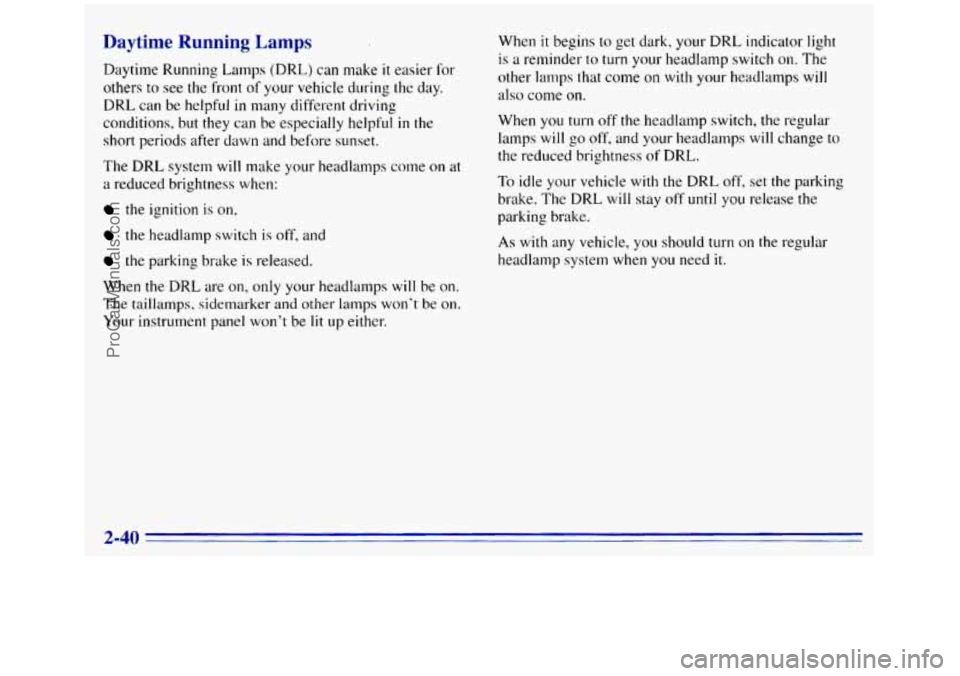
Daytime Running Lamps
Daytime Running Lamps (DRL) can make it easier for
others to see the front of your vehicle during the day.
DRL can be helpful in many different driving
conditions, but they can be especially helpful
in the
short periods after dawn and before sunset.
The
DRL system will make your headlamps come on at
a reduced brightness when:
the ignition is on,
the headlamp switch is off, and
the parking brake is released.
When the
DRL are on, only your headlamps will be on.
The taillamps, sidemarker and other lamps won’t be on.
Your instrument panel won’t be lit up either. When
it begins to get dark, your DRL indicator light
is a
reminder to turn your headlamp switch on. The
other lamps that
come on with your headlamps will
also come on.
When you turn off the headlamp switch, the regular
lamps will go off, and your headlamps
will change to
the reduced brightness of DRL.
To idle your vehicle with the DRL off, set the parking
brake.
The DRL will stay off until you release the
parking brake.
As with any vehicle, you should turn on the regular
headlamp system when
you need it.
2-40
ProCarManuals.com
Page 117 of 404
A. Dome Lamp Switch
B. Lamp Controls
C.
Air Outlets
D. Multifunction Lever
E. Instrument Cluster
E Gearshift Lever
G. Audio System
H. Comfort Control System
I. Glove Box
J. Storage Tray
K. Ashtray
L. Cupholder
M. Auxiliary Power Outlets
N. Storage Area or Compact Disc Player (Option)
0. Rear Window Defogger Switch (Option)
P. Tilt Lever (Option)
Q. Parking Brake Release
R. Hood Release
S. Fuse Block
2-55
ProCarManuals.com
Page 123 of 404
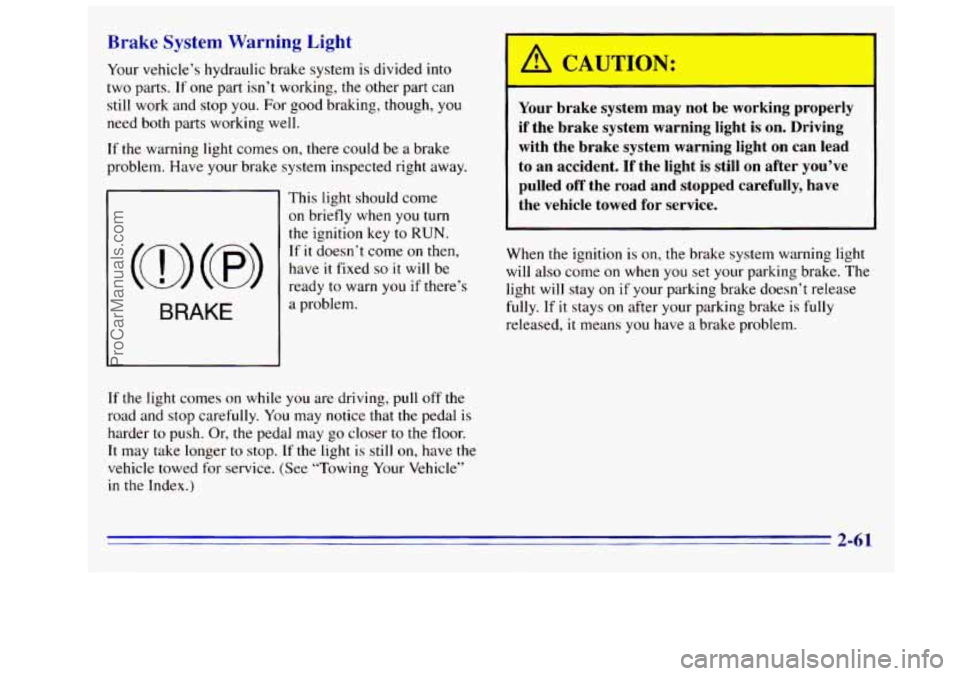
Brake System Warning Light r
Your vehicle’s hydraulic brake system is divided into
two
parts. If one part isn’t working, the other part can
still work and stop you. For good braking, though, you
need both parts working well.
If the warning light comes on, there could be a brake
problem. Have your brake system inspected right away.
BRAKE
This light should come
on briefly when
you turn
the ignition key to
RUN.
If it doesn’t come on then,
have
it fixed so it will be
ready to
warn you if there’s
a problem.
If the light comes on while you are driving, pull off the
road and stop carefully. You may notice that the pedal is
harder to push. Or, the pedal may go closer to the floor.
It may take longer to stop. If
the light is still on, have the
vehicle towed for service. (See “Towing Your Vehicle”
in the Index.)
I! CAUTION:
Your brake system may not be working properly
if the brake system warning light is on. Driving
with the brake system warning light on can lead
to an accident. If the light
is still on after you’ve
pulled
off the road and stopped carefully, have
the vehicle towed for service.
When the ignition is on, the brake system warning light
will also come on when you set your parking brake. The
light will stay on if your parking brake doesn’t release
fully.
If it stays on after your parking brake is fully
released,
it means you have a brake problem.
2-61
ProCarManuals.com
Page 124 of 404
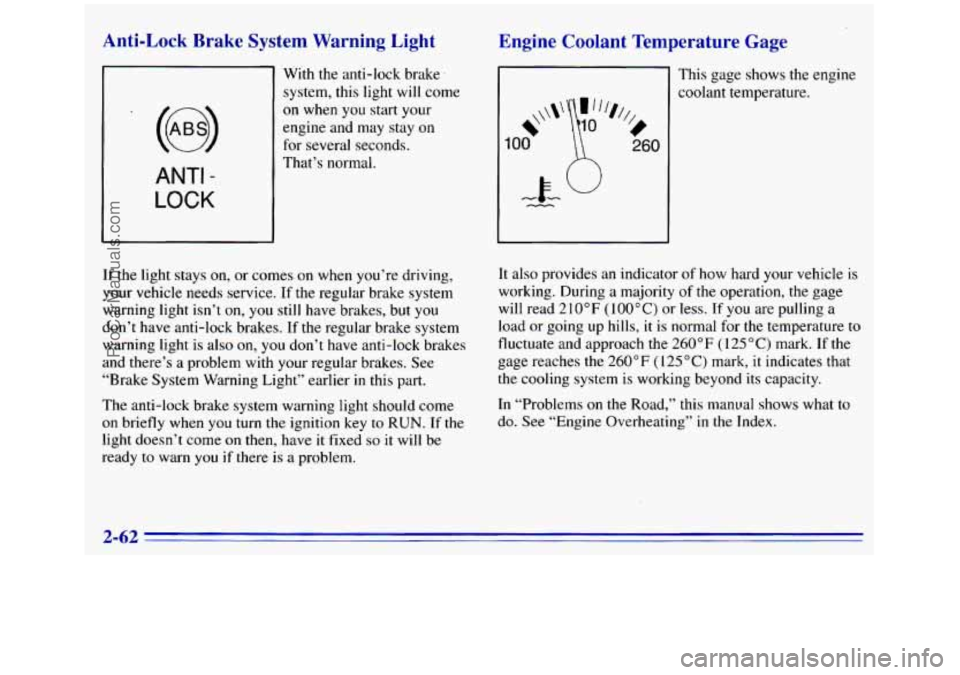
ANTI -
LOCK
Qnti-Lock Brake System Warning Light
With the anti-lock brake.
system, this light will come
on when
you start your
engine and may stay on
for several seconds.
That’s normal.
If the light stays on, or comes on when you’re driving,
your vehicle needs service.
If the regular brake system
warning light isn’t on,
you still have brakes, but you
don’t have anti-lock brakes.
If the regular brake system
warning light is also on, you don’t have anti-lock brakes
and there’s
a problem with your regular brakes. See
“Brake System Warning Light” earlier
in this part.
The anti-lock brake system warning light should come
on briefly when you turn the ignition key to RUN. If the
light doesn’t come on then, have it fixed so it will be
ready to warn
you if there is a problem.
Engine Coolant Temperature Gage
I This gage shows the engine
~ coolant temperature.
It also provides an indicator of how hard your vehicle is
working. During a majority of the operation, the gage
will read 210°F
(100°C) or less. If you are pulling a
load or going up hills, it is normal for the temperature to
fluctuate and approach the 260°F ( 125 “C) mark. If the
gage reaches the 260°F
(I 25 “C) mark, it indicates that
the cooling system is working beyond its capacity.
In “Problems
on the Road,” this manual shows what to
do. See “Engine Overheating” in the Index.
2-62
ProCarManuals.com
Page 155 of 404
Section 4 Your Driving and the Road
Here you‘ll find information about driving on different
kinds
of roads and in varying weather conditions. We’ve
also included many other useful tips on driving.
Defensive Driving
The best advice anyone can give about driving is:
Drive defensively.
Please start with
a very important safety device in your
vehicle: Buckle up. (See “Safety Belts”
in the Index.)
Defensive driving really means “be ready
for anything.”
On city streets, rural roads or freeways, it means
“always expect the unexpected.”
Assume that pedestrians
or other drivers are going to be
careless and make mistakes. Anticipate what they might
do.
Be ready for their mistakes.
Rear-end collisions are about the most preventable
of
accidents. Yet they are common. Allow enough
following distance. It’s the best defensive driving
maneuver,
in both city and rural driving. You never
know when the vehicle
in front of you is going to brake
or turn suddenly.
4-1
ProCarManuals.com
Page 159 of 404
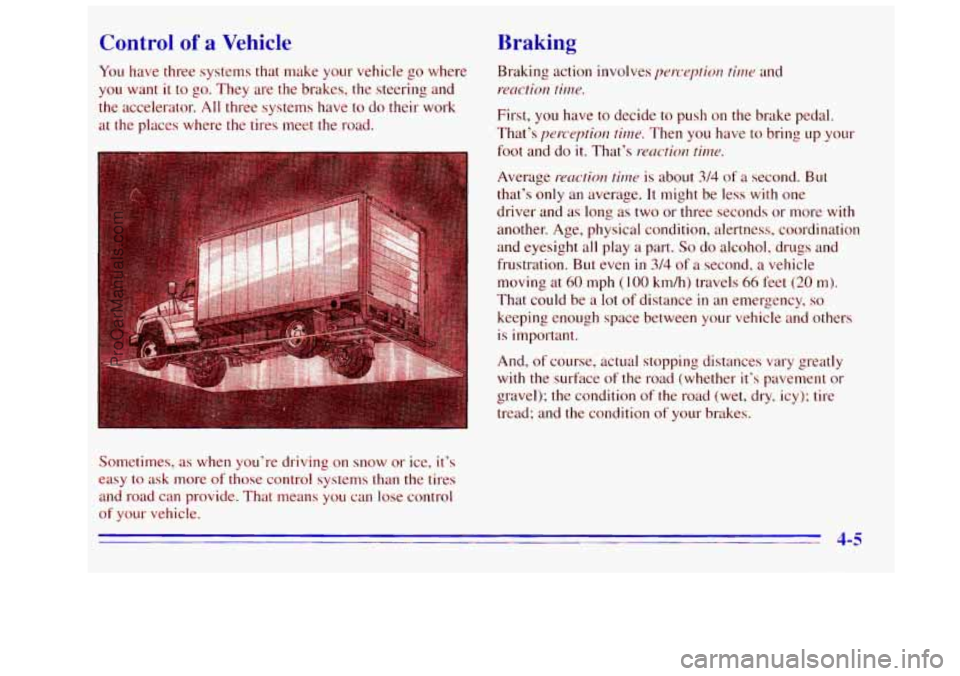
Control of a Vehicle Braking
You
have three systems that make your vehicle go where
you want it to go. They are the brakes, the steering and
the accelerator. All three systems have to do their work
at the places where the tires meet the road.
Sometimes, as when you’re driving
on snow or ice, it’s
easy to ask more of those control systems than the tires
and road can provide. That means
you can lose control
of your vehicle. Braking action involves
perception time and
reaction time.
First, you have
to decide to push on the brake pedal.
That’s
perception time. Then you have to bring up your
foot and do
it. That’s reaction rime.
Average reaction time is about 3/4 of a second. But
that’s only an average. It might be less with one
driver and
as long as two or three seconds or more with
another. Age, physical condition, alertness, coordination
and eyesight all play
a part. So do alcohol, drugs and
frustration. But even
in 3/4 of a second, a vehicle
noving at
60 mph (1 00 kmh) travels 66 feet (20 m).
That could be a lot of distance in an emergency, so
keeping enough space between your vehicle and others
is important.
And,
of course, actual stopping distances vary greatly
with the surface
of the road (whether it‘s pavement or
gravel);
the condition of the road (wet, dry, icy); tire
tread; and the condition
of your brakes.
4-5
ProCarManuals.com
Page 160 of 404
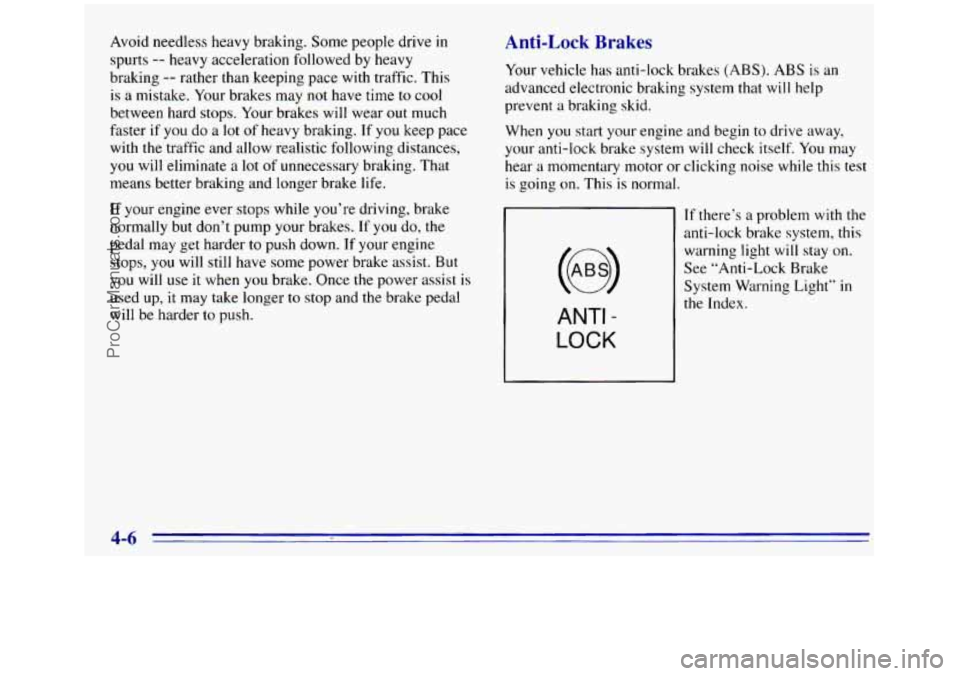
Avoid needless heavy braking. Some people drive in
spurts
-- heavy acceleration followed by heavy
braking
-- rather than keeping pace with traffic. This
is
a mistake. Your brakes may not have time to cool
between hard stops. Your brakes will wear
out much
faster
if you do a lot of heavy braking. If you keep pace
with the traffic and allow realistic following distances,
you will eliminate a lot of unnecessary braking. That
means better braking and longer brake life.
If your engine ever stops while you’re driving, brake
normally but don’t pump your brakes.
If you do, the
pedal may get harder to push down.
If your engine
stops, you will still have some power brake assist. But
you will use it when you brake. Once the power assist is
used up, it may take longer
to stop and the brake pedal
will be harder to push.
Anti-Lock Brakes
Your vehicle has anti-lock brakes (ABS). ABS is an
advanced electronic braking system that
will help
prevent
a braking skid.
When you start your engine and begin to drive away,
your anti-lock brake system will check itself. You may
hear
a momentary motor or clicking noise while this test
is going on. This is normal.
If there’s
a problem with the
anti-lock brake system,
this
warning light will stay on.
See “Anti-Lock Brake
System Warning Light’‘
in
ANTI -
LOCK
4-6
ProCarManuals.com